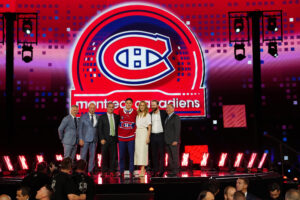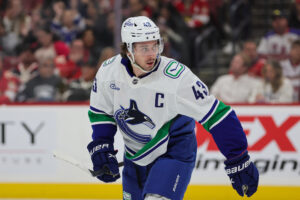For the fourth year of the Jim Benning tenure, the only thing the Vancouver Canucks excelled at was symbolism. In the last home game of the year, Daniel Sedin scored the game-winner and Henrik Sedin assisted on it. In overtime, yet. Rookie Brock Boeser led the team in scoring, Bo Horvat took on a leadership role, Jacob Markstrom established himself in net. The veterans were on the way out, the new blood coming in. The veterans included the President of Hockey Operations Trevor Linden. Speculation ran wild, mostly that the two managers disagreed on how the team would rebuild. The announcement insisted their parting was “amicable” but few people choose to walk from any job they describe as a “dream come true.”
Jim Benning Tenure
Then again, the 2017-18 season was so bad that if the “new blood” faltered in any way, it would have sealed Benning’s fate. That skinny kid they drafted the previous year played well in Sweden, but otherwise? Sven Baertschi looked good, but only managed 53 games. Erik Gudbranson didn’t, and he played one game less. Tepid as Loui Eriksson‘s offence was, he was still a good defensive player. Injuries also kept him to just 50 games. In fact, it could be argued that if there hadn’t been so many injuries the team would have done better! There are better ways to say your team isn’t deep enough, but few so emphatic.
Year Five – 2018-19
There were a couple of kids coming along. What was he going to do about it? They were going to try Elias Pettersson out at centre, the position they drafted him for. There was the base for a top line in Boeser, Horvat, and (a healthy) Baertschi. Neither Michael Del Zotto nor Derrick Pouliot could find their offence, so help was needed there. Heck, help was needed on the defence overall: they finished 24th, 24th, and 26th in goals-against over the past three years.
The Free Agents
Sven Baertschi would get his chance, with a three-year and $10 million deal. He skated well with Horvat and Boeser, so a bit of stability in their young line couldn’t hurt. Jake Virtanen showed signs of life, and Troy Stecher had proven himself as well. Both picked up two-year deals. But Stecher was a third-pairing defender, and Virtanen was hardly known for his defence. Better protection for Markstrom could be had by filling the defence – and there were slim pickings in the free-agent market there – or by adding defensively-minded forwards. Brandon Sutter was supposed to be that, but even he missed 20 games to injury.
Well.
Tim Schaller was signed on for two years at $1.9 million per. That was a surprise. More so was Antoine Roussel and Jay Beagle each signing on for four years and $12 million. With trade protection. The bidding war for 28-, 29-, and 33-year-old defensive forwards couldn’t have been that high, could it? Each of those players filled a slightly different role, sure: Schaller didn’t have the agitation or speed Roussel did, and Beagle was a centre. But why on Earth four years AND trade protection AND $3 million per year for Roussel and Beagle?
Price wasn’t the only perplexing question. On a team with defensive flaws – their best defensive defenceman had yet to play 71 games in a season after eight years – why three forwards?
The Trades
Compared to the atrocious free agent signings – the Beagle deal straight-up rivals Loui Eriksson‘s – this year, the Jim Benning tenure had some solid deals. Getting Josh Leivo for an unused Michael Carcone was a steal. The comedy of errors that was the Anders Nilsson/Mike McKenna/Whoops! Michael DiPietro‘s playing!; deal is partially on the team for being unprepared for a claim being made on a returning player. But even then, the primary objective was to shed salary, and that was accomplished. Del Zotto, Nillson, and Sam Gagner all were moved out for little return as the playoffs fell out of reach.
The notable exception – though no one knew it at the time – was getting out from Erik Gudbranson‘s $4 million hit in return for the Pittsburgh Penguin’s fourth-line winger Tanner Pearson. The bad signing was entirely salvaged in this deal – but the signing itself remains a black mark.
The Draft
This year, 2018, was a year of defencemen. The first player drafted was going to be Rasmus Dahlin, of that there was no doubt. But after that, closer to where the Canucks ended up in seventh? Defencemen galore! At least four were going in the top-10 spots, so it was dependent on who was left of Noah Dobson, Evan Bouchard, Adam Boqvist, and Quinn Hughes. Even Ty Smith would be a solid choice, should all four other prospects be gone. Well, unless Andrei Svechnikov was somehow around, but that wasn’t happening.
Fortunately for Vancouver, both the Montreal Canadiens and Arizona Coyotes decided to draft the centres they weren’t able to trade for. Hughes fell to the Canucks, giving them what they’ve needed for decades. Just to be sure, they added Jett Woo and Toni Utunen, known more as defensive stalwarts than point-producers. Batteries-Never-Die centre Tyler Madden was selected in the third round, giving them, by all accounts, a very solid draft.
[pickup_prop id=”3691″]
The Verdict for 2018-19
If anything marks the Canucks’ Jim Benning tenure it’s good drafting and pretty solid trading marred by fever-dream free-agent signings. The 2018-19 season might have the biggest difference in quality between the trades and the signings of any year. The team’s lack of preparedness forcing DiPietro into the lineup straight from the OHL was a clear mistake, but not as egregious as their free-agent deals. Would those have happened if Trevor Linden was still employed by the team? We’ll never know, of course, but fans can dream.
Year Four is here.
Main Photo:






